Gum Arabic Role in High Blood Pressure among Patients with Stage III Chronic Kidney Disease
Suad Y Alkarib1*, Amal M Saeed2, Sami A Khalid3, Elsir A Groun4 and Mohamed B Ghalib5
1College of Pharmacy, University of Karary, Omdurman, Sudan
2College of Medicines, University of Khartoum, Sudan
3College of Pharmacy, University of Science and Technology, Omdurman, Sudan
4College of Medical Laboratory, University of Science and Technology, Sudan
5College of Medicine, University of Karary, Omdurman, Sudan
Submission: June 22, 2016; Published: September 20, 2016
*Corresponding author: Suad Y. Alkarib, College of Pharmacy, University of Karary, Omdurman, Sudan.
How to cite this article: Suad Y A, Amal M S, Sami A K, Elsir A G, Mohamed B G. Gum Arabic Role in High Blood Pressure among Patients with Stage III Chronic Kidney Disease. J of Pharmacol & Clin Res. 2016; 1(4): 555569. DOI: 10.19080/JPCR.2016.01.555569
Abstract
Gum arabic acacia is a complex, loose aggregate of Gum arabic and hemicelluloses composed of arabic acid nucleus, it is found in nature and exists as a natural or slightly acidic calcium, magnesium, potassium or sodium salt of complex polysaccharide and the different metal ions present in gum arabic molecules. Chemically, it is an arabinose Gum arabic lactan protein complex composed by weight of 17-34% arabinose, 32-50% Gum arabiclactose, 11-16% rhamnose, 13-19% glucuronic acid and 1.8-2.5% protein. Hypertension is the most common cardiovascular disease that affects heart, brain, and hence damages blood vessels in the kidney, which leads to incidence of renal failure. So optimization of the blood pressure is beneficial for the kidney functions. This study is designed to determine the hypertension in kidney disease patients, which affect Gum arabictively direct on the kidney functions, and to evaluate the changes occurred in the Blood pressure in relation to gum arabic since it is rationally used in Sudan.
It is a Randomized control trial study, performed using (24) volunteers with different blood pressure readings and different kidneys function with six months past history. Dose of 10, 15, 20, 25 grams of gum dissolved in 250ml drinking water had been taken at the morning and were used for duration of 16- 18 weeks with interval every four weeks, the blood pressure recorded for first as a control and pre-post every interval. The result showed systolic pressure of (146.43+/- 28.18 before, 120.36+/- 11.51 after) with P-value of 0.004 while the diastolic was (80.00+/- 27.74 before, and 75.36+/- 7.96 after), with P-value of 0.552, which showed biological rearrangement optimized referenced readings, both systolic and diastolic. Mean While the serum sodium level at that dose showed significant decrease (137.86 +/-2.54 before, 135.00 +/-2.04 after) , with P- value of 0.003. It was concluded that there is a significant correlation between gum acacia and lowering of elevated systolic bp as well as positive correlation with serum sodium. On the other hand the correlation with diastolic blood pressure was not statistically significant.
Keywords: Gum Acacia; Blood Pressure; Salts; Renal Disease
Introduction
Gum arabic is a complex mixture of arabinose Gum arabiclactan oligosaccharides, polysaccharides, and glyco-proteins. It is a branched neutral or slightly acidic substance. The chemical composition and the composition of the mixture can vary with the source, climate, season, age of trees, rainfall, time of exudation, and other factors. The backbone has been identified to consist of b-(1→3)-linked d-Gum arabiclactopyranosyl units. The side chains are composed of two to five b-(1→3)-linked d-Gum arabiclactopyranosyl units, joined to the main chain by 1,6-linkages. Both the main and the side chain contain units of:
- a-l-arabinofuranosyl,
- a-l-rhamnopyranosyl,
- b-d-glucuronopyranosyl, and
- 4-O-methyl-b-d-glucuronopyranosyl [1].
The latter two usually occur preferably as end-units.
Depending on the source, the glycan components of gum arabinose which contain a greater proportion of l-arabinose relative to d-Gum arabic lactose (Acacia seyal) or d-Gum arabic lactose relative to l-arabinose (Acacia sene Gum arabic). The gum from Acacia seyal also contains significantly more 4-O-methyld- glucuronic acid but less l-rhamnose and unsubstituted d -glucuronic acid than that from Acacia Sene Gum Arabic [2]. Gum arabic has a complicated molar mass distribution. Some authors report a mixture of lower molar mass polysaccharide (Mw » 2.5×105 for the major component) and higher molar mass hydroxyproline-rich glycoprotein (Mw » 2.5×106 for the minor component) [3].
Others describe three fractions: arabinose Gum arabic lactan (88.4%) with 3.8×105g/mol, arabinose Gum arabic lactanprotein complex (10.4%) with 1.45×106g/mol, and a low molar mass glycoprotein (1.2%) with 2.5×105g/mol [4]. Because it is a mixture, which varies with source, the exact chemical composition and molecular structures are still debated. Gum arabic is proved to be effective in improving the renal profile in patients with kidney disease [5]. There is mounting evidence indicating that indoxyl sulfate contribute to progression of renal disease. Serum levels rise in parallel to the loss of kidney function [6]. Both animal experiments and in vitro cell culture work also support a role of indoxyl sulfate in perpetuating a profibrotic response driving a progressive decline in renal function [7,8]. The increase in short chain fatty acids associated with colonic bacterial saccharolytic activity is also associated with the health benefits of high fiber diets since SCFA are known to have a host of biologically important effects including modulation of cell proliferation, apoptosis, regulation of angiogenesis and inflammation [9]. Furthermore our in vitro work suggests that SCFA also have anti-fibrotic activities both reducing the generation and the biological activity of the pro-fibrotic cytokine Transforming Growth Factor-ß1 (TGF-ß1) [10].
Physico-chemical Characteristics of Gum Arabic
Gum arabic is odorless, colorless, tasteless, and does not affect the odor, color, and taste of the system to which it is added. It is highly soluble in water and dissolves in both cold and hot water with concentrations up to 50%. The solutions exhibit Newtonian behavior at concentrations up to 40% and become pseudo plastic at higher concentration. The viscosity of solutions varies strongly with the gum arabic type, pH, and ionic strength. Maximum viscosity is achieved between pH 6 and 7. Gum arabic acts as protective colloid and excellent emulsifier. Gum arabic was also found to be a useful prebiotic, which promotes beneficial physiological effects [11]. However, the name is also used for other gums produced by other Acacia species. Despite there being more than 500 species of acacia trees, most commercial gum arabic is produced from Acacia Sene Gum Arabic and Acacia seyal which are grown commercially through out the Sahel from Sene Gum Arabic and Sudan to Somaliland [12]. Prospective cohort studies shown inverse associations between fiber intake and CVD, possibly mediated by blood pressure (BP). However, little is known about the impact of types of fiber on BP. We examined cross-sectional associations with BP of total, insoluble and soluble fiber intakes [13].
The relationship between blood viscosity, hematocrit (Hct), and mean arterial blood pressure (MAP) was studied in a healthy population. The correlation between blood viscosity and Hct was linear and positive (r2 = 0.48) and identical to that of previous studies reported in the literature when men and women are taken as a single group. The present results suggest that studies that show a positive correlation between MAP and blood viscosity (and Hct) do not differentiate data according to gender [14-16]. In a study of only two patients, it was also suggested that dietary supplementation with locust bean gum improved both blood pressure control and also reduced serum creatinine [17].
The Blood pressure is independent of blood viscosity in healthy individuals could be of clinical interest since the population shows variability in these parameters. In particular, individuals with subclinical elevations of Hct and blood pressure could be a state of endothelial dysfunction that may progress to the clinical condition of hypertension [18]. In a different context these studies suggest that moderate elevation of blood viscosity is not necessarily a health hazard, and in some circumstances may be beneficial, an effect shown experimentally for the elevation of plasma viscosity in hemorrhage resuscitation, and cardiovascular effects due to the small acute elevation of Hct [19]. Increased plasma and blood viscosity are usually associated with pathological conditions, however there are several situations in which the elevation of both parameters results in increased perfusion and the lowering of peripheral vascular resistance. Moderate elevations of blood viscosity by increasing hematocrit (approximately 10% of baseline) result in reductions of blood pressure by 10 mmHg of baseline, the relationship between hypertension and blood rheological changes, which affect vessel diameter in the microcirculation leading to counter intuitive responses to the increase in viscosity, which explored by performing transversal population studies in healthy subjects, taking advantage of the naturally occurringvariability in hematocrit and therefore blood viscosity [20]. Recent observational population studies have shown that the association between dietary sodium intake and blood pressure level in adults is less than initially reported. In randomized trials, the average fall in blood pressure from moderate sodium restriction is small, although benefits may be larger in the elderly [21].
Higher levels of sodium intake are reported to be associated with higher blood pressure. Whether this relationship varies according to levels of sodium or potassium. Similar has more recently been reported from the central Sudan in a cohort of patients undergoing regular haemodialysis in which supplementation with 50 g/day of Gum Arabic led to improvement of their biochemical profile. Significant drop of systolic blood pressure was reported in this study in correlation with administration of gum arabic however lowering below the normal level was not reported and this was evident by continuity of administration of gum arabic for 18 weeks which reported stable readings without Hypotension [22]. Although insoluble fiber particles may affect viscosity measurement, viscosity is not an issue. In conclusion, our study provides good evidence of a strong association between blood viscosity and arterial pressure, independently of many possible confounding factors, summarizing the findings of the Edinburgh Artery Study, which evaluated the blood pressure/viscosity association in 1592 men and women aged 55–74 years [23]. After multivariable adjustment, total fibre intake higher by 6•8 g/4184 kJ (6•8 g/1000 kcal) was associated with a 1•69 mmHg lower systolic blood pressure (SBP; 95% CI -2•97, -0•41) and attenuated to -1•01 mmHg (95% CI -2•35, 0•34) after adjustment for urinary potassium. Insoluble fibre intake higher by 4•6 g/4184 kJ (4•6 g/1000 kcal) was associated with a 1•81 mmHg lower SBP (95% CI -3•65, 0•04), additionally adjusted for soluble fiber and urinary ‘K’ excretion. In conclusion, higher intakes of fiber, especially insoluble, may contribute to lower BP, independent of nutrients associated with higher intakes of fibre-rich foods [24]. Potassium is important in controlling blood pressure because potassium lessens the effects of sodium [25].
Objectives
- To see the correlation of gum arabic with blood pressure in patients with stage III chronic Kidney disease, and the Hypertension, Which affect directly on Gum arabic which is positive on the kidney functions, and hence on the Biological balance of the cardiovascular system.
- To evaluate the changes occurred in the Blood pressure in relation to gum arabic which composed of different acidic salts and Gum arabic proteins complex.
Rationale of the Study
A similar finding has recently been reported from the Central Sudan [26]. It should be emphasised however that these findings are not universally accepted and shortfalls in study design as well as studies with less dramatic effects on renal function have recently been highlighted [27]. To date, although there are numerous health claims which are made for dietary supplementation with Gum Arabic, however these are not widely accepted in clinical practice. It is clear that a structured program of clinical studies as a “proposed clinical trial protocol of Gum Arabic use in chronic kidney disease”. The dose selected to be used in the trial will be the least effective dose of Gum Arabic that lowers the serum indoxylsulphate and increases the SCFAs concentrations, supported by good mechanistic basic science which is now needed to explore the potential health benefits of Gum Arabic, to re-establish a medical application for Gum Arabic.
Materials and Methodology
Material
Gum Acacia from Kordofan region in west Sudan was collected and prepared as required for usage in this study. Microbial test was done to get sure free of microbes (Table 1).
Type of the study
It is a Randomized control clinical trial study.
Ethical consideration
The study protocol was ethically reviewed and approved by the ethical reviewing committee of the research directorate- Federal Ministry of Health, Khartoum.
Place of the study
In Khartoum different Known Kidney disease centers, Salma center, Ibn Seena, Ahmed Gum arabicsim and Arif centre.
Population of the study
24 Kidney patients volunteers in stage III with keratinize not more than 5 and GFR 10 mls per minute with back history of six months before.
Dosage of gum arabic
Gum arabic was given in a building up dosage as follows for duration of 16- 18 weeks with interval every four weeks for every dose:
- Different weights of gum arabic in instant soluble form were dissolved into 250 mls of drinking water.
- The weights were 10 gms, 15 gms, 20 gms and 25 gms.
- All the volunteers were started with the 10gm in 250ml water taken for 4 weeks.
- The dose was given orally in early morning on daily basis. It was then increased to 15 gms, 20 gms and finally to 25 gms each for 4 weeks interval.
- The dose selected to be used in the trial will be the least effective dose of Gum Arabic that lowers the serum indoxylsulphate and increases the SCFAs concentrations. A reduction of serum urea due to increased bacterial nitrogen excretion in the faeces was reported almost 20 years ago. In favor of a positive effect, work performed over 10 years ago in Khartoum, suggested beneficial effect on blood biochemistry following dietary supplementation with 50g/day in patients with CKD [28].
- Blood pressure was reported for each volunteer for first as a control baseline, and pre-post every dose .
The data was computed in SPSS version 20 and ANOVA was obtained.
Results
(Tables 1 & 2), (Figures 1-3).
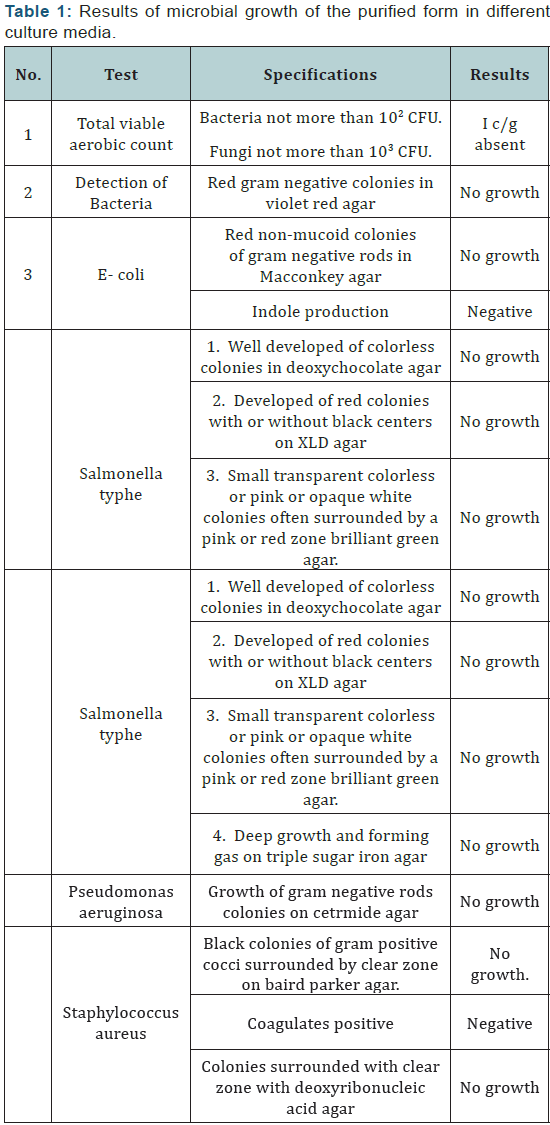
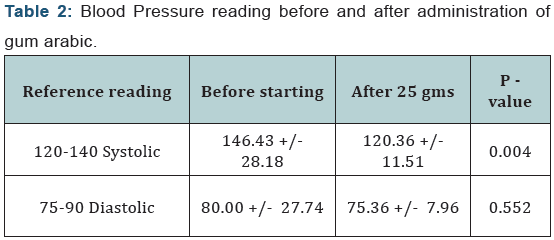
Statistical Data Analysis
Were done based on mean +/- stander deviation (SD) using ANOVA statistical one way to investigate Gum arabic in the variance significance. In all analysis of data generated from in vivo studies the probability p-value 0.05 was considered as appoint for significance for both Systolic and diastolic blood pressure and other parameter Na+, K+. (Individual 95% CIs For Mean Based Pooled St-Dev) (Table 3).

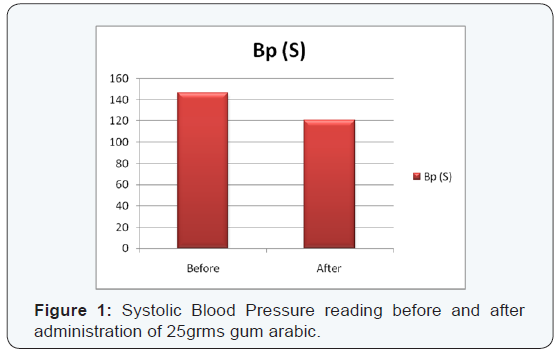
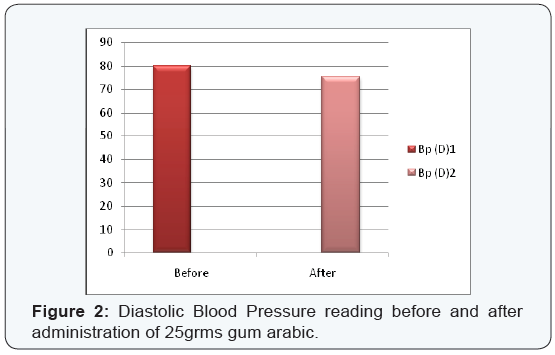
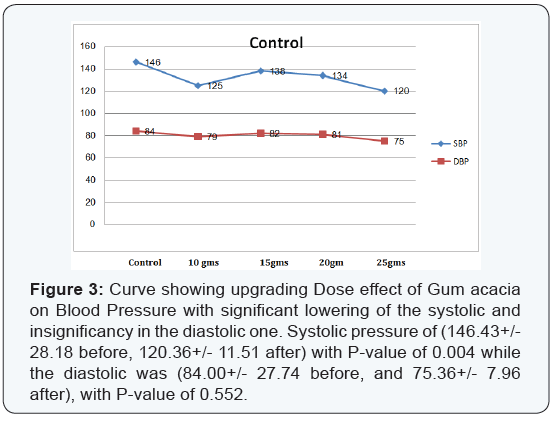
Blood pressure showed very clear systolic decreased readings while the diastolic one is not. Meanwhile the Serum Sodium level showed significant decrease (Figures 4 & 5).
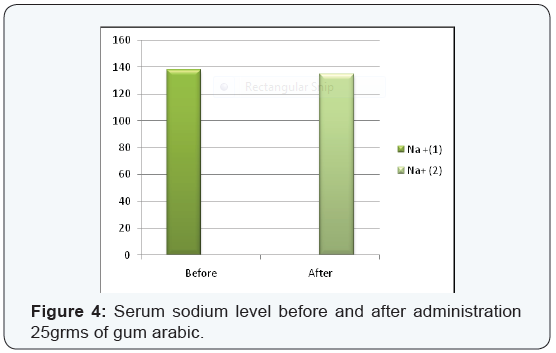
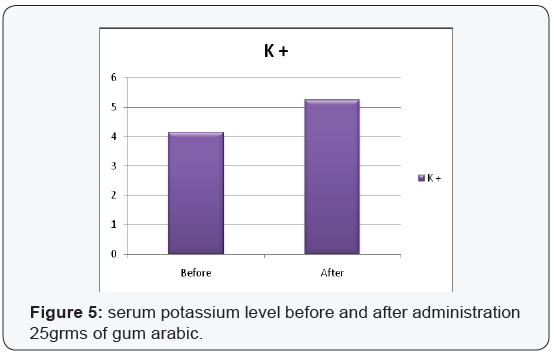
Discussion
Alteration of Blood pressure in patients with renal diseases is well documented in the literature. Gum arabic is frequently used traditionally in kidney disease. These trial findings showed positive effects in restoring the normal readings of Blood Pressure. Moreover serum sodium was also dropped in correlation with gum arabic (p value 0.003). This may also couple the drop of systolic blood pressure. On the contrary the diastolic pressure was not significantly affected. This may be related to the influence of the soluble fiber portion of gum arabic on blood viscosity. Viscosity is a physicochemical property associated with dietary fibers, particularly soluble dietary fibers. Viscous dietary fibers thicken when mixed with fluids. It includes polysaccharides such as gums, pectins, psyllium, and beta-glucans. The study showed significant association with Gum arabic administration and adjusting the readings of the BP with significant lowering in the systolic pressure (p-value 0.004, meanwhile restoring the level of serum sodium to normal values which affect directly on the Blood pressure and even serum potassium which showed significant increase up to the upper normal value (P-value 0.000). On the other hands there are no significant changes in the Diastolic Blood Pressure (P-value 0.552). Hence the upper normal range of the Systolic Blood Pressure reading is 120 and that for the Diastolic is 80, this means that for both readings the safest normal and stable range for healthy person is below (SBP 120>90) and (DBP 80>60). The kidney’s ability to excrete or conserve sodium is a key factor for blood pressure regulation. Most studies show that a reduction in salt intake reduces blood pressure, the effect being greatest in those with high blood pressure, the obese and the elderly. Response to salt reduction is highly variable between individuals and may not provide measurable benefits to people already within normal BP ranges.
In contrast, reduced blood pressure is linked to increased potassium intakes which may be due to potassium’s ability to increase sodium excretion and the vasoactive effects of potassium on blood vessels. High amount of sodium in the blood stream wrecks the delicate balance, reducing the ability of the kidneys to remove the water. Increasing potassium levels helps to restore the delicate balance, this will help the kidneys to work more efficiently and helps to lower the blood pressure to a healthy level , that because potassium lessens the effects of sodium in hypertensive person . On other hands Potassium supplementation are not observed when sodium level is kept low, while Potassium is a chemical which helps to lower blood pressure by balancing out the Gum arabic effects of salt . Meanwhile low potassium in the blood causes muscles crams which leads to vasoconstrictive effect on the blood vessels, and hence elevates the blood pressure.
Conclusion
There is a significant correlation between Gum acacia and Blood Pressures as monitor with hypotensive avoidance consideration, it seems depending on the Gum components ratios. The study showed significant lowering association with Gum arabic administration and adjusting the level of serum sodium to normal values (p value 0.003) and serum potassium increase with (p value 0.000), these two factors seems to be of great value in controlling the Blood Pressure. Treatment of hypertension in CKD patients should taken into consideration. This data sheds light on a new era of Hypertension management that worth further studies. Hence long duration clinical trial (more than 4months) using dose more than 25gms and enough patient volunteers, will be beneficial to assess the sustainability of the optimum Blood pressure readings and its advantages on clinical events and kidney disease severity. This study may need further investigation on Gum arabic to establish the relationship between the amount of salts constituents in gum arabic and serum salts level.
Acknowledgement
My appreciation to University of Karary, College of Pharmacy, to Dr. Tag Elsir, the president of Gum Board, Dr. Abdalmagid for their support, and to the Medical Committee in the Board. To any one Shares me this project.
References
- Phillips (2000) Handbook of Hydrocolloids pp. 155-168, PA Williams & GO Phillips, et al. (Eds.), (2006) Polysacharides and their applications (2nd edn), pp: 455-495.
- Motlagh S, Ravines P, Karamallah KA (2006) The Analysis of Acacia Gum using Electrophoresis. Food Hydrocolloids 20(6): 848-854.
- Renard D, Lavenant Gourgeon L, Ralet MC, Sanchez C (2006) Acacia senegal Gum: Continuum of Molecular Species Differing by Their Protein to Sugar Ratio, Molecular Weight, and Charges. Biomacromolecules 7(9): 2637-2649.
- Verbeken D, Dierekx S, Dewttlink K (2003) Microbiol Biotechnol 63: 10-12.
- Sami A Khalida, Abdelrahman M Musa, Amal M Saeed, Elsir A Abugroune, Elamin O Sid Ahmed, et al. (2014) Manipulating dietary fibre: Gum Arabic making friends of the colon and the kidney. Bioactive Carbohydrates and Dietary Fibre 3(2): 71-76.
- Matsumoto N, Riley S, Fraser D, Al Assaf S, Ishimura E, (2006) Butyrate modulates TGF-beta1 generation and function: Potential renal benefit for Acacia(sen) SUPERGUMtrade mark (gum arabic). Kidney Int 69(2): 257-65.
- Adiotomre J, Eastwood MA, Edwards CA, Brydon WG (1990) Dietary fiber: in vitro methods that anticipate nutrition and metabolic activity in humans. Am J Clin Nutr 52(1): 128-134.
- Annison G, Trimble RP, Topping DL (1995) Feeding Australian Acacia Gums and Gum Arabic Leads to Non-Starch Polysaccharide Accumulation in the Cecum of Rats. J Nutr 125(2): 283-292.
- Ali BH, Ziada A, Blunden G (2009) Biological effects of gum arabic: a review of some recent research. Food Chem Toxicol 47(1): 1-8.
- Glover DA, Ushida K, Phillips AO, Riley SG (2009) Acacia(sen) SUPERGUM: An evaluation of potential health benefits in human subjects. Food Hydrocolloids 23(8): 2410-2415.
- Phillips GO, Ogasawara T, Ushinda K (2007) The regulatory and scientific approach to defining gum arabic (Acacia senegal and Acacia seyal) as a dietary fibre. Food Hydrocolloids 22: 24-35.
- Verbeken D, Dierekx S, Dewttlink K (2003) Gum, Resins, and Latexes of plant origin. Microbiol Biotechnol 63: 10-12.
- Aljuraiban GS, Griep LM, Chan Q, Daviglus ML, Stamler J, et al. (2015) Total, insoluble and soluble dietary fibre intake in relation to blood pressure: the INTERMAP Study. Br J Nutr 114(9): 1480-1486.
- Devereux RB, Case DB, Alderman MH, Pickering TG, Chien S, et al. (2000) Possible role of increased blood viscosity in the hemodynamics of systemic hypertension. Am J Cardiol 85(10): 1265-1268.
- de Simone G, Devereux RB, Chinali M, Best LG, Lee ET, et al. (2005) Association of blood pressure with blood viscosity in American Indians. The strong heart study. Hyper aha 45(4): 625-630.
- Letcher RL, Chien S, Pickering TG, Sealey JE, Laragh JH (1981) Direct relationship between blood pressure and blood viscosity in normal and hypertensive subjects. Role of fibrinogen and concentration. Am J Med 70(6): 1195-1202.
- Ueda H, Shibahara N, Takagi S, Inoue T, Katsuoka Y (2007) AST-120, an oral adsorbent, delays the initiation of dialysis in patients with chronic kidney diseases. Ther Apher Dial 11(3):189-195.
- Fowkes FG, Lowe GD, Rumley A, Lennie SE, Smith FB, et al. (1993) The relationship between blood viscosity and blood pressure in a random sample of the population aged 55 to 74 years. Eur Heart J 14(5): 597- 601.
- Cabrales P, Tsai AG, Intaglietta M (2007) Is resuscitation from hemorrhagic shock limited by blood oxygen-carrying capacity or blood viscosity. Shock 27(4): 380-389.
- Martini J, Carpentier B, Chávez Negrete A, Cabrales P, Tsai AG, et al. (2006) Beneficial effects due to increasing blood and plasma viscosity. Clin Hemorheol Microcirc 35(1-2): 51-57.
- Grobbee DE (1994) Electrolytes and hypertension results from recent studies. Am J Med Sci 307(1): 17-20.
- Ali AA, Ali KE, Fadlalla AE, Khalid KE (2008) The effects of gum arabic oral treatment on the metabolic profile of chronic renal failure patients under regular haemodialysis in Central Sudan. Nat Prod Res 22(1): 12- 21.
- Dikeman CL, Fahey GC (2006) Viscosity as related to dietary fiber. Crit Rev Food Sci Nutr 46(8): 649-663.
- Aljuraiban GS, Griep LM, Chan Q, Daviglus ML, Stamler J, et al. (2015) Total, insoluble and soluble dietary fibre intake in relation to blood pressure: the INTERMAP Study. Br J Nutr 114(9): 1480-1486.
- Mente A, O’Donnell MJ, Rangarajan S, McQueen MJ, Poirier P, et al. (2014) Association of Urinary Sodium and Potassium Excretion with Blood Pressure. N Engl J Med 371(7): 612-623.
- Miyazaki T, Ise M, Seo H, Niwa T (1997) Indoxyl sulfate increases the gene expressions of TGF-beta 1, TIMP-1 and pro-alpha 1(I) collagen in uremic rat kidneys. Kidney Int Suppl 62: 15-22.
- Iida S, Kohno K, Yoshimura J, Ueda S, Usui M, et al. (2006) Carbonicadsorbent AST-120 reduces overload of indoxyl sulfate and the plasma level of TGF-beta1 in patients with chronic renal failure. Clin Exp Nephrol 10(4): 262-267.
- Miyazaki T, Ise M, Hirata M, Endo K, Ito Y, et al. (1997) Indoxyl sulfate stimulates renal synthesis of transforming growth factor-beta 1 and progression of renal failure. Kidney Int Suppl 63: 211-214.







